10 Types of Black Birds in Oklahoma (With Pictures)
Last Updated on
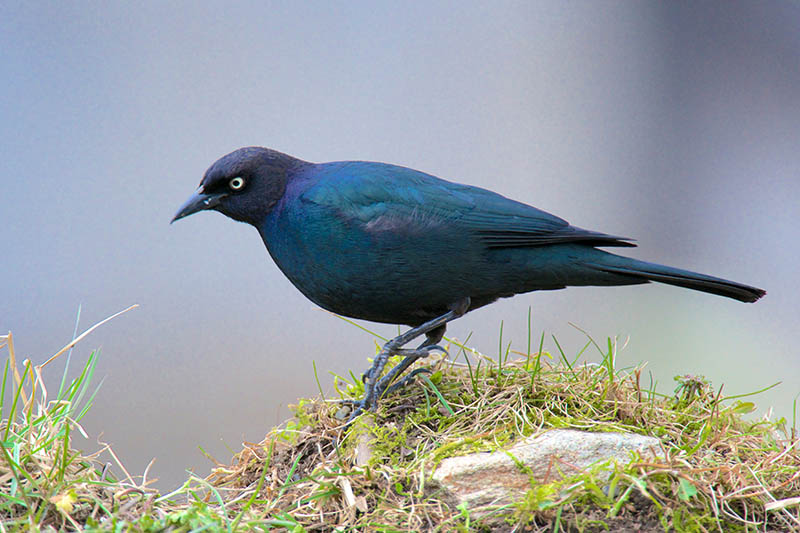
There’s really no denying the fact that birds make incredible first pets. Of course, some people may disagree, but what’s better than an animal that can be seamlessly integrated into any household, to teach kids about the responsibility of taking care of something?
Of course, like all birds, black birds are incredible when viewed in their natural habitat. Supposing you’re a resident in Oklahoma or are planning a birdwatching visit, these are some of the black bird species found in the state.

The 10 Types of Oklahoma Black Birds
1. Common Grackle
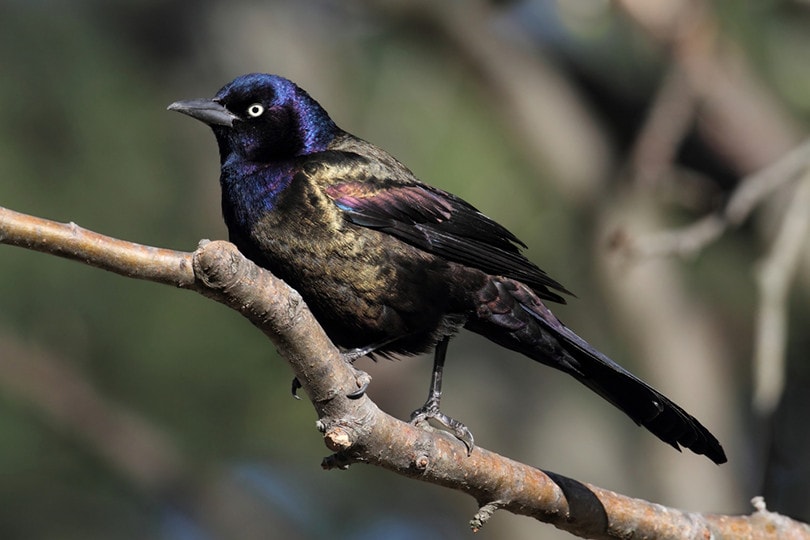
| Weight: | 2.6–5.0 oz (74–142 g) |
| Length: | 11.0–13.4 in (28–34 cm) |
| Wingspan: | 14.2–18.1 in (36–46 cm) |
While the Common Grackle might be one of the most spotted birds in Oklahoma, it’s still listed as near threatened. What that means is that their population is highly concentrated in this region, but rapidly decreasing in others.
There are many contributing factors to this phenomenon. However, researchers speculate that the number one cause is climate change—a topic that has become polarizing over the years.
These birds are partial migrants. A section of the community will migrate south as the temperatures start dropping, while the rest remain behind to survive on the little that’s left in their depleted food stores.
They are not your typical blackbird, seeing as they usually come with a relatively long tail, and look taller. Telling the males and females apart is not that difficult, as you’ll notice the ladies have a dull plumage coloration.
We really can’t give you an accurate description of their habitats, since they are found almost everywhere but in the desert. If you’re an avid birder, you could try looking for them in the agricultural fields, in parking lots, in parks, or in open woodlands.
2. Brown-Headed Cowbird
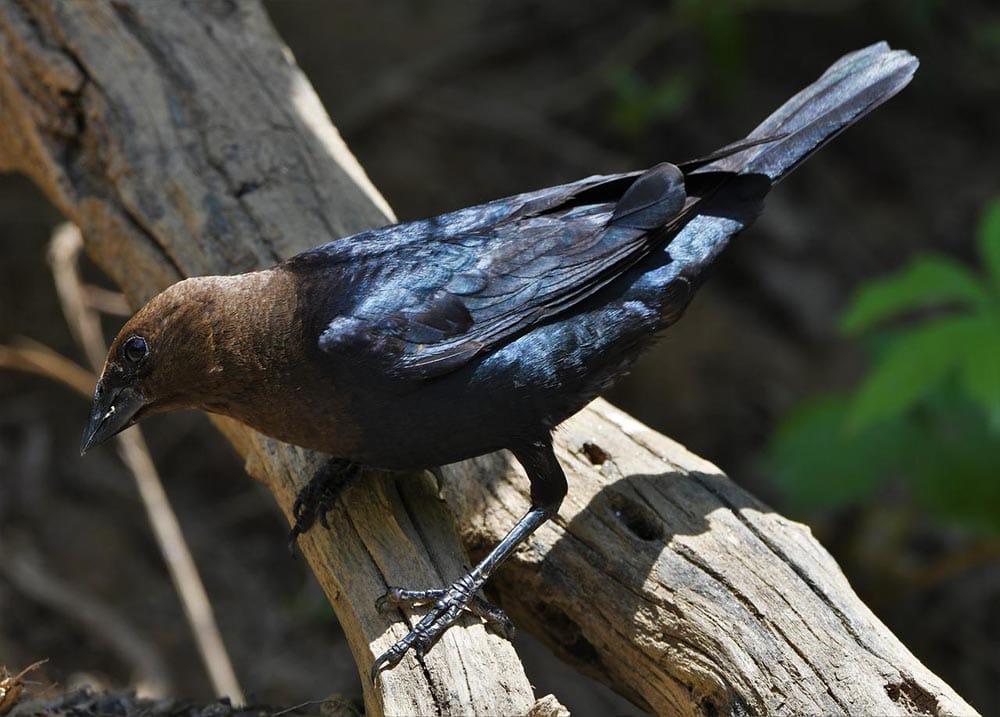
| Weight: | 1.5–1.8 oz (42–50 g) |
| Length: | 7.5–8.7 in (19–22 cm) |
| Wingspan: | 14.2 in (36 cm) |
Our Brown-Headed feathery friends are also common in Oklahoma. And just like the Common Grackle, they are partial migrants. During winter, they’ll fly to warmer states. But in the summer, those high-pitched whistles will fill the air every morning and late in the evening.
This species loves to pay birders frequent visits. From seeds, they usually get all the healthy fats, zinc, iron, and protein they need. Egg shells, on the other hand, supply calcium. That said, they love feeding on insects just as much.
The Brown-Headed Cowbird is an obligate brood parasite. This is the descriptive phrase designated for birds that choose to not build their own nests, but instead, lay eggs in the nests built by other species.
The females are quintessentially smaller than their spouses, and have a gray-brown plumage, with slight streaking. The males are chiefly black in color, have dark-brownish heads, and shorter tails.
It’s possible to spot this species in a wooded area, but they love the grasslands more. Something else that we took note of was their propensity to hang around agricultural fields that have grazing animals. Probably because the animals make it easier for them to fill up their bellies!
3. Red-Winged Blackbirds
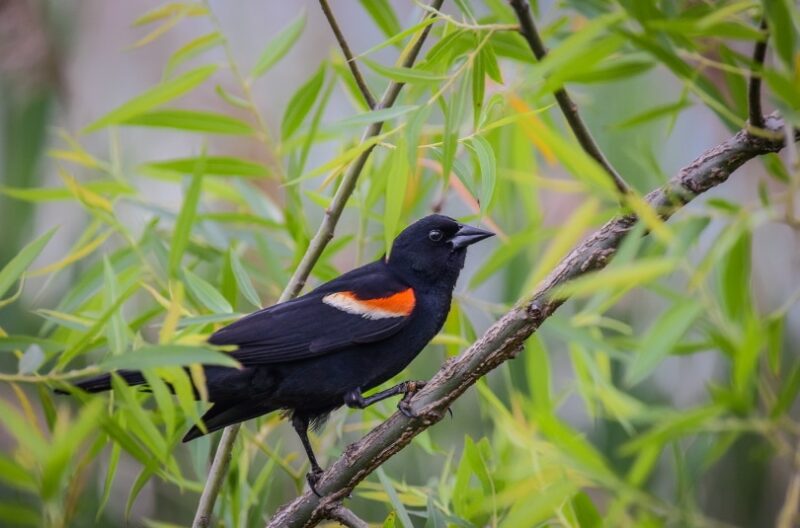
| Weight: | 1.1–2.7 oz (32–77 g) |
| Length: | 6.7–9.1 in (17–23 cm) |
| Wingspan: | 12.2–15.8 in (31–40 cm) |
At this point, it’s safe to assume that this Red-Winged species can be found in almost all states in the country. And although they are generally migratory, they are strong enough to weather any storm.
In the summer, they won’t want anything to do with you or your yard feeders as food is plentiful in the wild. But when winter sets in, and they realize that they are quickly running out of options, they’ll shamelessly camp in your backyard, waiting for you to throw them some scraps.
You can easily identify a Red-Winged bird even if you’ve never seen one before. Their plumage is very black, with reddish-orange badges on the shoulders. The males look brighter than the females, who happen to have streaky brown colorings.
Are they territorial? Very. They’ll attack anything or anyone who invades their personal space, even if the enemy weighs 10 times their weight.
Red-Winged birds are insectivores. They’ll spend their summers hunting and eating insects, then turn to seeds during winter.
As the breeding season approaches, they’ll start building nests very close to the ground. The vegetation in that area has to be dense to conceal the eggs from predators and give them an opportunity to flee before being caught.
4. European Starlings

| Weight: | 2.1–3.4 oz (60–96 g) |
| Length: | 7.9–9.1 in (20–23 cm) |
| Wingspan: | 12.2–15.8 in (31-40 cm) |
Starlings have been around for generations. They are now considered natives, but they never used to be. You see, these birds were brought into the country by Shakespeare enthusiasts who traveled from Europe and western Asia.
From a distance, they’ll appear black. However, if you keep moving closer, you’ll start noticing some blue, green, and purplish tones. In addition, they are glossier than most species.
Steer clear of the Starling bird, if you’re only interested in luring friendly birds to your backyard. Saying that this species exhibits aggressive behavior is an understatement, since it always invades, fights, and even kills all species that have already claimed your yard as their territory. They’ll go as far as destroying all their eggs and maiming the hatchlings.
Should you decide to lure them, fill your feeders with peanuts, corn, suet, or sunflower seeds. Their preferred nest-building materials are pine needles, cobwebs, grass, and anything that feels soft. The female will lay an average of 3 to 6 eggs, and then kick off the incubation process immediately—which usually takes 10 to 14 days, depending on the conditions.
5. Shiny Cowbirds
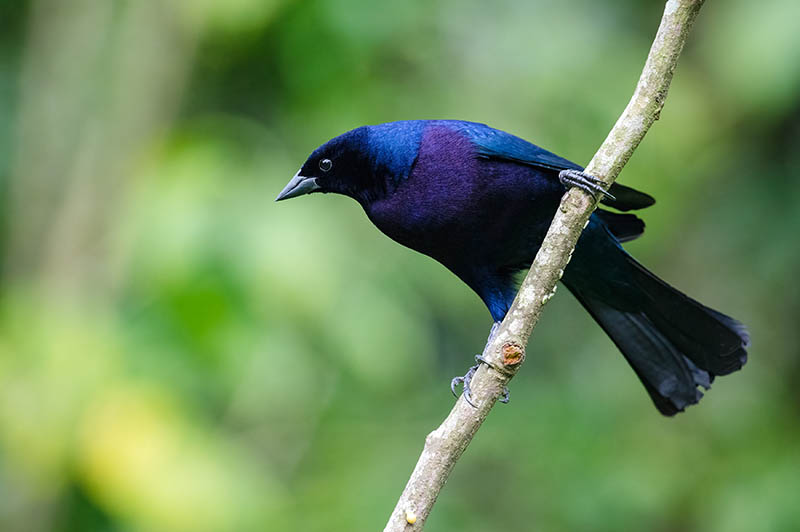
| Weight: | 1.01–1.4 oz (31–40 g) |
| Length: | 7.1 in (18 cm) |
| Wingspan: | 11.8 in (30 cm) |
We’re not exaggerating when we say the Shiny Cowbird is very rare—especially in Oklahoma. The bird hasn’t been tagged as near-threatened, but in this state, the last Shiny was spotted decades ago.
Identifying the male or the female is difficult, as they resemble other species. You’ll assume the males are purely black from a distance, only to realize that they are velvety purple up close. On the other side, the females have a plumage that’s akin to that of a Brown-Headed Cowbird.
Shiny Cowbirds don’t have a problem interacting with humans, so they’ll show up in your backyard if they are in town visiting. Ornithologists have classified them as “part-granivores-part-insectivores,” because they snack on insects from time to time if they are not foraging for grains. Also, these birds are known for brood parasitism.
6. Bronzed Cowbird

| Weight: | 1.5–1.8 oz (42–50 g) |
| Length: | 7.5–8.7 in (19–22 cm) |
| Wingspan: | 14.2 in (36 cm) |
Another member of the Cowbird family just made it to the list, owing to the fact that these species generally prefer the same habitat—open fields, grasslands, wooded areas, etc. Their breeding season kicks off during summer, so that’s the best time to study their courtship process.
You should know there’s no Bronzed Cowbird community in any state found in the northern regions of the country. And just like their peers, this species prefers laying its eggs in a host’s nest. Once the females are done laying their seasonal clutch, they’ll leave and never come back.
Compared to the other Cowbird species, this one looks stockier and larger. All the males (eastern or western species) have similar descriptive features, including dark blue wings and red eyes. The females, though, come in different shades. The ones found on the eastern side of the state are a lot darker than the population that inhabited the western side. If you come across a Cowbird species with black eyes, it’s definitely a juvenile.
The first thing they do when they wake up in the morning is forage. They’ll eat anything that looks like a grain, seed, or invertebrate.
7. Bobolink

| Weight: | 1.0–2.0 oz (29–56 g) |
| Length: | 5.9–8.3 in (15–21 cm) |
| Wingspan: | 10.6 in (27 cm) |
The Bobolinks are not Oklahoma natives. They only come to visit during spring and fall, then go back home to wherever they came from. Identification of this species is very easy, as the males have a pale-yellow patch behind their heads, dark bellies, and white backs. Their partners have the same descriptive traits as the non-breeding males—brown-streaked plumage, with striped crowns.
Bobolinks are able to cover close to 1,100 miles in a single day. They’ll stop for a couple of days to refuel, and maybe catch a breath, then continue with the journey.
Those who are interested in studying Bobolinks can find them in the coastal areas, near marshes, or in open grasslands. The grasslands provide suitable breeding sites for couples that are ready to start a family. Their nests are usually built on the ground, so watch your step if you’re going to explore that area.
Sadly, the Bobolink population is in drastic decline. Whilst their breeding population is close to 8 million, researchers believe they used to be way more than that. The causal factors listed include climate change and the destruction of habitats.
8. Rusty Blackbird
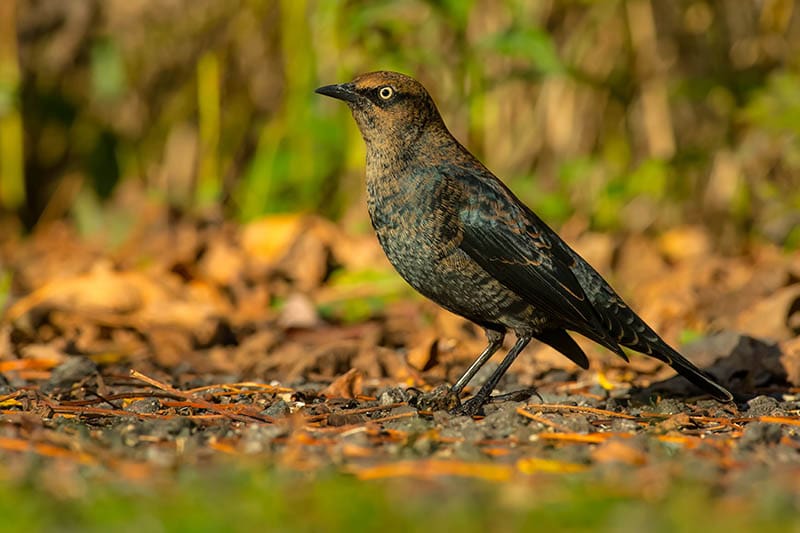
| Weight: | 1.7–2.8 oz (47–80 g) |
| Length: | 8.3–9.8 in (21–25 cm) |
| Wingspan: | 14.6 in (37 cm) |
The Rusty Blackbird is also a threatened species. If you take a quick look at its conservation status, you’ll note that it’s been marked as “vulnerable.” Meaning their population started declining decades ago. And even though we’ve tried everything within our power to reverse that trend, that curve is still on a downward trajectory.
The major contributing factor, in this case, is habitat loss. And teams of experts have conducted several studies over the years, and come to the conclusion that multiple factors contribute to that destruction.
Mercury contamination is one reason. We think the mercury gets access to their avian systems through the food that they consume. The waste matter often channeled to oceans, seas, and various other water bodies has been known to contain a significant percentage of this element. It ends up poisoning the fish and worms, ultimately affecting the birds that eat them. The Rusty Cowbird is one of those birds.
Both adults have black plumage that comes with a gloss that looks greenish-purple. To an extent, they look like the Brewers. But that shouldn’t be surprising, considering they all belong to the same genus. The name “Rusty” was given to the species because it develops a brownish plumage during winter.
9. Yellow-Headed Blackbird
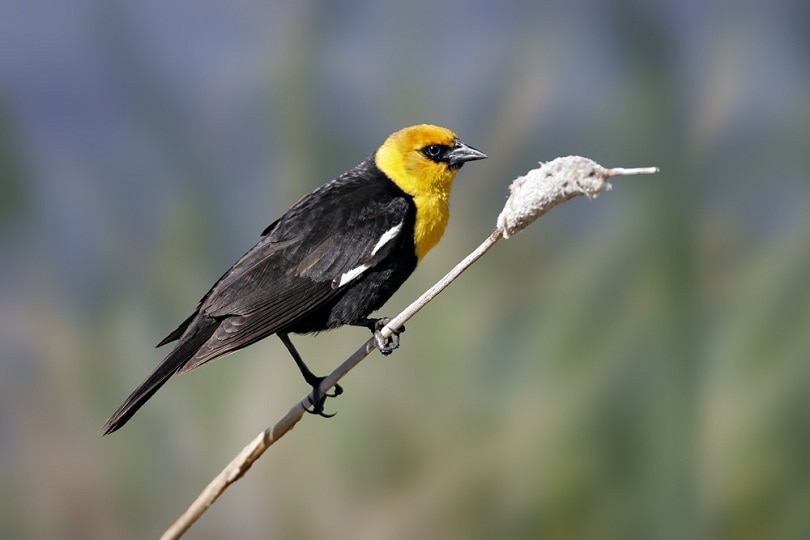
| Weight: | 1.6–3.5 oz (44–100 g) |
| Length: | 8.3–10.2 in (21–26 cm) |
| Wingspan: | 16.5–17.3 in (42–44 cm) |
They are not as common as some other black birds but are fairly common during spring. Their frequent occurrence during that period has been attributed to migration because they love spending time in warmer regions.
Yellow-Headed birds are beautiful. Their plumages are always dark, their heads bright yellow (hence the name), and the males have a few white patches on their shoulders. The females also have a yellow head, but it’s not as bright as the one observed on their partners. Plus, their plumages are more or less brown, and not black.
The closest relative to this species is the Red-Winged Blackbird. Other than the plumage color you can also use their sizes to tell them apart. The Yellow-Headed bird is comparatively larger in size.
These birds love nesting in the reeds and breeding in prairie wetlands. The nests are always constructed over water, using different materials such as wet stems, and grass. The female will lay a clutch of two to five eggs, and then incubate them for 14 days. Once they’ve hatched, they’ll fledge after another 2weeks.
Yellow-Headed black birds mostly feed on insects and only resort to grains or seeds if the supply is low. They are very aggressive while hunting insects, to the point they start flipping stones upside down.
10. Brewer’s Blackbird
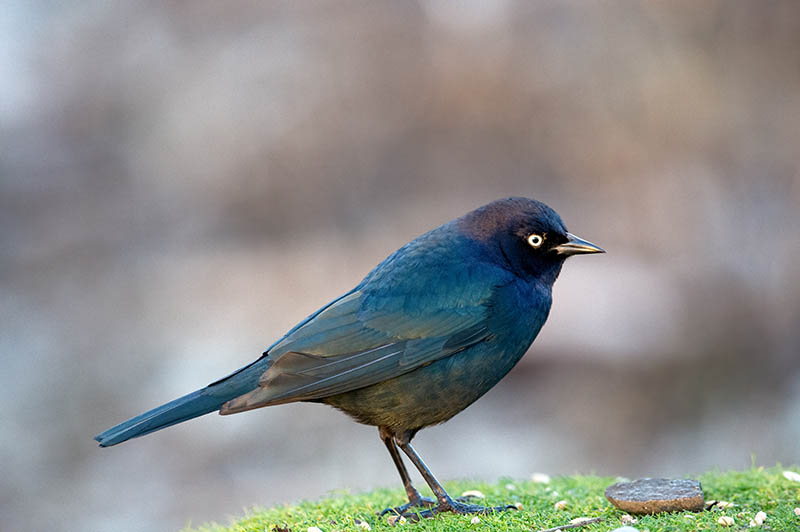
| Weight: | 2.1–3.0 oz (60–86 g) |
| Length: | 8.3–9.8 in (21–25 cm) |
| Wingspan: | 1.8–2.4 oz (50–67 g) |
The Brewers have always been listed as “regularly occurring” in the state. They’ll be all-year-round residents even in northern Oklahoma, a region that experiences extreme sub-zero temperatures. That doesn’t mean that they don’t migrate, because they do. Some leave for a little while, and others remain behind.
Both genders are medium-sized, but the colorations vary. The females are normally plain brown, while the males wear glossy black coats, with some lighter shade of purple on the head. Their natural habitats are areas close to human settlements, along the coasts, marshes, woodlands, and grasslands. You could say they’ll settle in any environment that has the potential of sustaining quality life
For example, agricultural fields. The livestock grazing in those fields is all the sign they need to gauge whether or not their type of food will be available.
Quite frankly, they’ll eat anything that looks nutritious. We used to think they only consume invertebrates, grains, and seeds, but they are often seen eating fruits and even vegetables.

Attracting Black Birds to Your Backyard
- You don’t have to have a green thumb to plant a garden that’s capable of luring blackbirds to your yard. Just plant those easy-to-grow fruiting plants and see what happens. If vegetable plant seeds are easily accessible, go for peas, melons, corn, or sunflowers. If berries are readily available, work with strawberries, raspberries, or blackberries.
- Birds are living organisms. They need clean water to stay hydrated and clean themselves. Fortunately for you, blackbirds don’t like bathing in water that But you still have to serve them some, seeing as staying hydrated is important to their overall wellbeing.
- Mimic their ideal habitat. Your landscape should have some shrubs, soft grass, sheltering trees, etc. If you can include a pole or two, that’s great too. These birds really love high vantage points, where they can get a clear line of sight of what’s approaching. That’s how they often protect themselves from intruders and predators.
- Keep your pets away. Don’t allow your cats or dogs to play in the yard.
- The yard should also be able to lure earthworms, insects, rats, lizards, and anything else that black birds consider prey. An abundance of food is reason enough for them to stay for an extended period.

Conclusion
It’s important to note that some of these species have their populations rapidly decreasing. And as much as we’d hate to point fingers, the truth is, humans are to blame for what’s currently happening. We’ve destroyed their habitats and contributed to the low food supplies that they are experiencing. If you’d like to give them a fair shot at life, join the green movement, and advocate for change.
Related Read: 13 Types of Black Birds in Arizona (With Pictures)
Featured Image Credit: Danita Delimont, Shutterstock
About the Author Robert Sparks
Robert’s obsession with all things optical started early in life, when his optician father would bring home prototypes for Robert to play with. Nowadays, Robert is dedicated to helping others find the right optics for their needs. His hobbies include astronomy, astrophysics, and model building. Originally from Newark, NJ, he resides in Santa Fe, New Mexico, where the nighttime skies are filled with glittering stars.
Related Articles:
Monocular vs Telescope: Differences Explained (With Pictures)
10 Types of Hummingbirds in Arkansas (With Pictures)
8 Types of Hummingbirds in Nebraska (With Pictures)
5 Types of Hummingbirds in Idaho (With Pictures)
3 Types of Hummingbirds in Mississippi (With Pictures)
8 Types of Hummingbirds in Kansas (With Pictures)
5 Types of Hummingbirds in West Virginia (With Pictures)
5 Types of Hummingbirds in Ohio (With Pictures)
